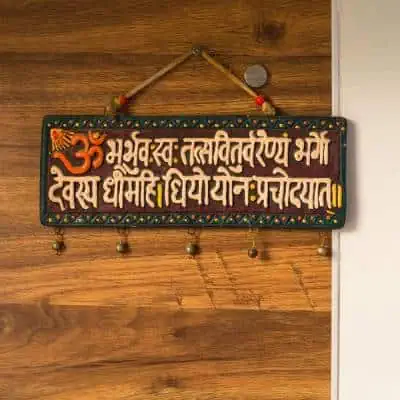Listen to this article:
Whether you attend yoga classes at a studio or practice online, you’ve most likely encountered some words that don’t sound English. This is because an ancient Indian language called Sanskrit was traditionally used in the practice of yoga, and some of these words are still used today.
If you’ve fallen in love with yoga and its incredible benefits, learning some Sanskrit terms will help you better understand what you are doing on your mat and why. Don’t worry; you don’t need to learn a new language to get the most out of your practice. Here are the most essential yoga words every yogi should know.
Contents
- 1 The Ancient Language Of Sanskrit
- 2 The Link Between Sanskrit And Yoga
- 3 8 Sanskrit Words Every Yogi Needs To Know
- 4 12 Sanskrit Words To Improve Your Yoga Practice
- 5 8 Sanskrit Words To Deepen Your Yoga Knowledge Further
- 6 Sanskrit Wall Decors To Hang In Your Home
- 6.1 12” Om Lotus Wall Art | 12” Diameter - 1/8” Thick | Wooden Wall Art, Crystal Grid, Chakras,...
- 6.2 Zen Decor, Namaste Wall Decor, Buddha Wall Art - 8x10 Poster Print for Yoga Meditation Room, Spa...
- 6.3 ExclusiveLane Terracotta Gayatri Mantra Wall Décor for Home | Religious/Spiritual Wall/Door Hanging...
- 7 Final Thoughts On Sanskrit Words
The Ancient Language Of Sanskrit
Sanskrit is an ancient language that originates in the Indian subcontinent among the Hindu tradition. It is the oldest of all the Indo-European languages and has influenced many newer Indian languages. Some people believe that Sanskrit was the first language of the universe as it was the language used in the earliest accepted scriptures of the human race; the Vedas.
Sanskrit was the predominant language in India until around the 13th century. Today, it is mainly used in Hindu prayers, rituals, and Buddhist chants.
The Link Between Sanskrit And Yoga

Sanskrit appears in yoga as the ancient yogic texts, such as Pantajali’s Yoga Sutras, were written in this language. Although these texts have now been translated into English, using yoga’s Sanskrit roots is an integral part of preserving the ancient practice of yoga.
Moreover, along with staying true to yoga’s roots, it is believed that Sanskrit words have potent spiritual energy and can stimulate the energy centers within us (known as the chakras). This is because each letter of the Sanskrit alphabet carries high vibrational sound quality and each Sanskrit word has its own inherent sound and healing properties. Therefore, by using Sanskrit terminology, we can advance along the path of yoga while staying true to its roots.
8 Sanskrit Words Every Yogi Needs To Know
Let’s start with some of the most common Sanskrit words you have probably already heard.
Yoga
Because yoga is now a worldwide phenomenon, many people do not release that yoga is a Sanskrit word. The word yoga translates as “to yoke” but is better described as “to unite” or “to join.” This union refers to the joining of the mind, body, and spirit the practice evokes.
Yoga also refers to the union between the individual self and the divine. Through yoga, we discover that we are not separate individuals but part of the universal energy. Therefore, this famous Sanskrit word represents the universal connection between humans, nature, and god.
Asana
Asana is something you do multiple times in a yoga class. The Sanskrit word Asana means posture or yoga pose, but the literal translation is “seat.” That’s why many of the Sanskrit names of many yoga poses end in asana, such as Uttanasana (Standing Forward Fold), Utkatasana (Chair Pose), and Dhanurasana (Bow Pose).

Hatha
If you look at the schedule of any yoga studio, you’ll likely see a bunch of Sanskrit words for the class names. This is because the practice of yoga has different lineages, which are what we know today as yoga styles.
Hatha yoga is one of the oldest and most known yoga styles. The Sanskrit word Hatha means sun and moon (Ha: sun, Tha: moon). Thus, the purpose of Hatha Yoga is to balance the opposing forces (energies) in the body to bring you into total harmony.
Vinyasa
Vinyasa is a style of yoga categorized as flowing from one posture to the next and can also mean the transition between asanas. The English translation of vinyasa is “in a special way,” which in vinyasa yoga refers to the placement of the poses.
Vinyasa means to link yoga poses together in a particular way. This is with the breath, as you typically inhale into one pose, then exhale into the next.
Ashtanga
The yoga style and lineage Ashtanga means “the eightfold path.” To break the Sanskrit word down: Ashta means eight, and Anga means organ or body part. However, it is not about using eight different body parts like in Muay Thai’s “art of eight limbs.” Instead, the eightfold path in Ashtanga yoga refers to the eight aspects of yoga practice, including asana, meditation, and breathing techniques.
Shanti
Shanti is a familiar Sanskrit chant, usually chanted three times after the word Om. Shanti means peace, and chanting this Sanskrit word invokes peace and the end of suffering for all living things.

Chakra
The Sanskrit word Chakra translates to “wheel” but refers to the energetic centers in our subtle bodies, which spin clockwise like wheels. We cannot see this energy, but when we practice yoga, we work to open and cleanse the seven chakras so that we can experience the positive qualities of each one and move along our spiritual path.
Prana
Prana means “life force,” similar to the Chinese word Chi (also spelled qi). The literal translation is “life wind,” referring to the air we breathe. Without air, there is no life, so prana refers to the essential act of breathing that sustains life and the energy that flows through every living thing.

12 Sanskrit Words To Improve Your Yoga Practice
By understanding the meaning behind these Sanskrit terms, you’ll be able to take your yoga practice to a much deeper level.
Bandha
The Sanskrit word Bandha means “bond” or “bind” and refers to three energetic locks used in yoga to lock vital energy. The three bandhas are the Jalandhara bandha, which happens when you tuck the chin to the chest, the Uddiyana bandha, which occurs when you contract the abdomen into the rib cage, and the Mula Bandha (contraction of the perineum).
Drishti
Drishti refers to vision and sight and is the focal point in a yoga pose. Each asana has a specific Drishti; this might be to look up, down, straight ahead, or to a particular body part. For example, in standing balances, your Drishti should be straight ahead on a point that isn’t moving.
Drishti is also used in meditation, usually at the tip of your nose or between the eyebrows. In yoga and meditation, Drishti helps you steady your mind and focus.
Mudra
Mudra means “seal” and is the Sanskrit word for a symbolic hand gesture used for channeling energy flow. Each mudra has a different intention and unique qualities. The most known mudra in yoga is the Gyan mudra, where you join the index finger to the thumb.

Mantra
A mantra is a chant of a specific Sanskrit word or group of words. When you chant sacred words or phrases, you experience their powerful vibration. Chanting mantras also helps to clear your mind and focus your energy ahead of yoga or meditation practice. Some mantras require a specific rhythm or repetition to evoke the spiritual power it holds.
Pranayama
Pranayama comes from the root word prana, which we discussed earlier. As prana means “life force,” pranayama is about controlling that life force, or in simpler terms, breath control. We all breathe continuously throughout the day, but this is not what pranayama is. Instead, pranayama is conscious control and direction of the breath.
We can control our breath in many ways, and each technique has a different intention. For example, some pranayamas are calming while others are energizing.
Dhyana
Dhyana is the Sanskrit word for meditation and is the seventh limb of the eight-limbed union taught in Ashtanga yoga and the yoga sutras. Dhyana refers to the union of the mind, body, and soul you experience with inner peace and self-awareness.

Tantra
Tantra is one of the most misinterpreted words in Sanskrit. The Sanskrit word Tantra translates to “loom” or “weave” and is a metaphorical term for how various yogic teachings are woven into one discipline. It also refers to a specific instructional text presented as a dialogue between a god and a goddess.
Kundalini
Kundalini means “coiled power” or “coil of energy”. The kundalini yoga lineage believes that we all have serpent energy (the shape of a coil) sitting dormant at the base of our spine (the Muladhara chakra). The practices of kundalini yoga help awaken that force and bring it up through the spine to the crown of the head, where one will attain enlightenment.
Kriya
The most common translation for the Sanskrit word Kriya is “completed action,” but it can also be described as a deed or effort. The root “Kri” means to create; thus, Kriya refers to the outcome of that creation or action.
In kundalini yoga, a kriya is a specific cleansing technique, such as a type of breathwork. The outcome of a Kundalini kriya is to raise consciousness and advance along your spiritual journey.

Nadi
Nadi means “energetic channel” or a tube where energy runs through the body. In yogic teachings, there are three Nadis within us; the Ida Nadi (left channel), the Sushumna Nadi (central channel), and the Pingala Nadi (right channel).
Agni
In the Sanskrit language, Agni means fire, coming from the fire god in Hindu mythology. This Hindu god is said to be the fire of the sun, lightning, and the domestic and sacrificial hearth.
In yoga and Ayurveda, Agni refers to the subtle pranic force of the fire element we have inside ourselves. Specific yoga postures, breathing techniques, and foods can dampen or increase the Agni within us.
Samadhi
Samadhi is the Sanskrit word for spiritual enlightenment and the last of the eight limbs of yoga. When we achieve Samadhi, we reach a state of complete union and, thus, achieve the goal of yoga. It is a state of transcendence, ecstasy, and bliss.

8 Sanskrit Words To Deepen Your Yoga Knowledge Further
Have you been practicing yoga for a while and are intrigued about what is beyond the poses? If so, these Sanskrit words will increase your yogic knowledge significantly.
Dharma
Dharma is a beautiful Sanskrit word for purpose. The word’s root means “to hold or to support” and is closely linked to the concept of duty. Thus, dharma refers to our unique purpose in life and the right way of living we should follow.
Karma
Karma is a well-known word to describe the consequences of our actions. It represents the spiritual law of cause and effect and how we are solely responsible for what happens to us. According to the law of Karma, what happens to a person happens because of their previous actions.
Maya
Maya is the fundamental Hindu concept of illusion. It refers to the formless god’s power (AKA the mind) to make humans believe in what is not real and suggests that the world we perceive through our senses is inaccurate. This is because the human mind constructs a subjective experience of the world, which is not the ultimate reality.

Ananda
The Sanskrit word Ananda means bliss, which according to yogic and Hindu philosophy, is the highest state of being. In the ancient Indian text, the Upanishads, Ananda is an attribute of Brahman’s supreme being. This state is experienced when you attain the ultimate goal of yoga, enlightenment, and the end of the rebirth cycle.
Bhakti
The English translation of Bhakti is unfaltering devotion. It means loyalty or faith that is absolute and without question. Bhakti yoga is the yoga of devotion, one of the oldest forms of yoga. In Bhakti yoga, the goal of reaching enlightenment is through worship and involves chanting and devotional singing.
Jnana
The Sanskrit word Jnana comes from another of the oldest yoga styles. Jnana means spiritual knowledge, wisdom, or deep understanding. In Jnana yoga, it is believed that you achieve union with the divine by gaining knowledge inseparable from the total experience of reality.

Svadhyaya
Svadhyaya is one of the five Niyamas stated in the yoga sutras by Indian sage Patanjali. Svadhyaya refers to self-study and gaining self-awareness. In modern-day times, Svadhyaya is the inner work and personal development we do to better understand ourselves, break free from our limiting beliefs, and release the constraints of the ego.
Tapas
If you envision small plates of delicious Mediterranean food when you hear Tapas, you’ll be surprised to hear that it is also a Sanskrit word. Tapas means self-discipline and is another of the five Niyamas. Tapas is the generation of heat attained through exercising discipline. This energy can then be used to achieve spiritual power or purification.
Sanskrit Wall Decors To Hang In Your Home
You can tap into the powerful qualities of Sanskrit words by speaking, chanting, or displaying them in your home as wall art. Here are three beautiful Sanskrit words and mantras that will add a touch of spirituality to your living space.
12” Om Lotus Wall Art | 12” Diameter - 1/8” Thick | Wooden Wall Art, Crystal Grid, Chakras,...
See latest priceOm (or Aum) is the most commonly chanted Sanskrit word. It is typically chanted at the beginning or end of a yoga class. There is no direct English translation for this word as Om, but it essentially means “the original sound,” as it is believed Om was the first sound to be created in the universe and the one from which all other sounds come.
So why do we chant it while practicing yoga? Because ancient yogis believed that chanting om creates a powerful vibration that helps you tap into universal energy. Hanging this Om wall decor in your home will remind you of your connection to the divine.
Zen Decor, Namaste Wall Decor, Buddha Wall Art - 8x10 Poster Print for Yoga Meditation Room, Spa...
See latest priceYou only have to attend a few yoga classes to hear the well-known Sanskrit word Namaste. Many yoga teachers end their sessions by bringing their hands into the prayer position and saying Namaste to their students. But what does Namaste mean?
The literal translation of Namaste is “I bow to you.” Breaking down this Sanskrit word, Nama means bow, As means I, and Te means you. However, one of Namaste’s most popular and beautiful interpretations is “The divine in me honors the divine in you.” Therefore, it can be a greeting, a farewell, or simply a way of showing love and respect.
Namaste comes from the root word Namaskar, the traditional Indian gesture of respect, accompanied by hands in a prayer position and a slight bow. This Namaste wall poster features the complete translation of this powerful word and a beautiful Hamsa Hand Mandala design.
ExclusiveLane Terracotta Gayatri Mantra Wall Décor for Home | Religious/Spiritual Wall/Door Hanging...
See latest priceThe Gayatri Mantra is one of the oldest and most potent Sanskrit mantras. It is believed that chanting this mantra increases learning power and concentration and brings prosperity. By hanging this terracotta Gayatri Mantra plaque on your wall, you can receive the qualities of this mantra all day long.
The mantra translates to “O Divine mother, may your pure divine light illuminate all realms (physical, mental, and spiritual) of our being. Please expel any darkness from our hearts and bestow upon us the true knowledge.”
Final Thoughts On Sanskrit Words
By learning these Sanskrit terms, you’ll not only know what your yoga teacher is saying during class, but you’ll also understand the practice on a deeper level.
If you want to increase your Sanskrit knowledge further, you can seek a spiritual teacher who is well-rehearsed in Sanskrit to help you learn the correct pronunciation. I also recommend reading The Cambridge Introduction to Sanskrit, a comprehensive but accessible Sanskrit guide for all levels.





